
Institute of
Cognitive Integrated Sensor Systems
Prof. Dr.-Ing. Andreas König

Advanced Methods for the Automation of Intelligent Sensor System Design
Subject:
Intelligent or smart sensor systems find more and more application in substantially different shape as the involved sensors and the applications show increasingly strong diversity. Also, the plethora of involved algorithms for multi-dimensional signal processing and recognition and their parameterization impose a severe load on a designer. Commonly, such a design process is conducted in a time-consuming, costly way, strongly relies on available expert knowledge, and potentially or even very probably will return suboptimum results. This contradicts market requirements, such as fast availability, low cost, high performance, and high efficieny. In this project, particular to the needs of embedded/integrated multi-sensor systems, design automation techniques are investigated and developed. The emerging methodology is embodied in a Matlab-based toolbox.
Abstract:
A shift of paradigm in the field of computation is evident, that led from one computer for many users to a single (personal) computer for a user to a plethora of computing devices for a single user. In particular, the increasing diversity of sensor types give incentive to this development and adds complexity to the required design process. Many embedded/integrated computing systems with expressed sensorial capability, e.g., for Ambient Intelligence, robotics, or distributed automation applications, will combine signal acquisition, conditioning, multi-dimensional signal processing, and decision making. The processing steps can be affiliated to hardware and software as well as to analog or digital domain as depicted by the following figure:
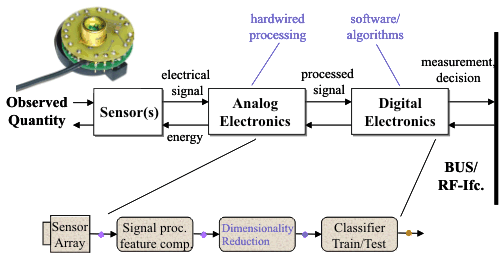
The design process of the recognition system itself is challenging and has to meet numerous constraints, e.g., limited design time, cost, performance, robustness, real-time requirements, hardware and power limitations. Typical iterativeflow of design activities for sensor system:
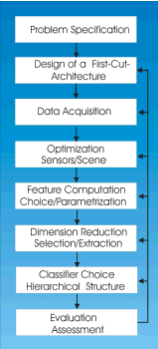
Commonly, such a design process of method choice, combination, and parameterization is experted driven, relies strongly on manual work, is tedious, slow, costly, and probably will not meet all constraints:

As a replacement of expert-centered design, in this work automation options of the design process as an emerging effective alternative are investigated. This activity is strongly linked with parallel activities at ISE on image processing system design automation, but here the focus is on the particularities and need of potentially heterogeneous sensors and embedded/integrated, mobile implementations. Observation of system performance is achieved by appropriate performance measure, e.g., computed from classifiers performance (kNN, SVM) or feature space assessment (Overlap, separability, compactness, see QuickCog). These observations provide the baseline for optimization to determine appropriate methods, method combinations, and setting of method parameters:

The complexity of the overall task will commonly not allow a global solution of the optimization problem. A divide-et-impera scheme usually is employed, solving from sensor data acquisition to decision making a chain of local optimization problems. Methods from Evolutionary Computation, e.g., genetic algortihms (GA) or swarm intelligence (Particle Swarm Optimization, PSO) are employed. Incorporation of a priori knowledge for search limitation and more economic computation is a key feature of interest for efficient system design.
The approach has been employed to dimensionality reduction, e.g., feature selection and decision making stages of sensor systems. In these stages the closest relations to image processing systems can be found. Scene and data acquisition as well as feature computation optimization are more particular to general sensor systems and are mainly pursued in this activity. One brief example of feature computation for gas sensor benchmark data supplied by Lehrstuhl für Messtechnik, Saarland University, will be given in the following. Four test gases (H2, CH4, Ethanol and CO) were measured at two different humidity levels and different concentrations by a commercial micro sensor (MiCS 5131) in prescribed heating cycles. The following figure gives the sensor response patterns during two temperature cycles after power up at t = 0:
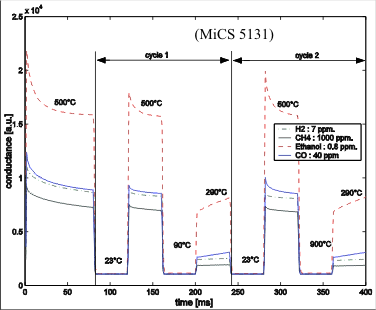
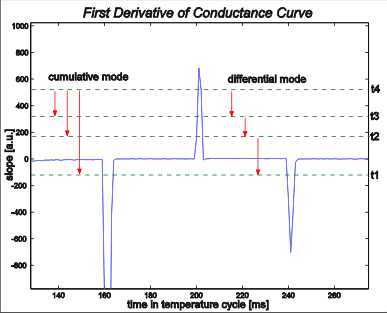
Based on available expert knowledge, manually defined thresholds were known as baseline solution. A GA was employed in this work to find improved locations for the same number of thresholds. The result is summarized in the following table:
No. Threshold |
Manual |
Automated |
t1 |
-100 |
-18.160 |
t2 |
-10 |
-18.159 |
t3 |
0 |
-7.091 |
t4 |
10 |
12.936 |
t5 |
100 |
14.115 |
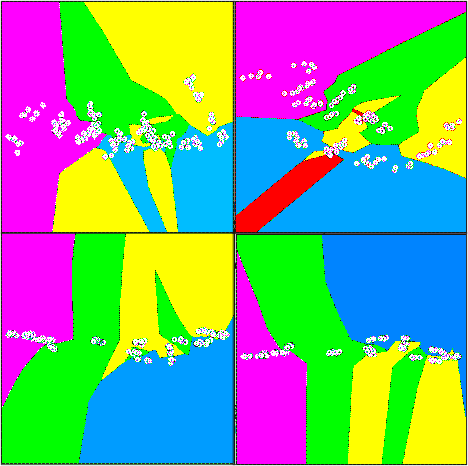
The following table shows on result obtained, where the optimized feature computation by automated finding of threshold values outperformed the expert solution:
Measurement |
Manual |
Automated |
Qov (training dataset) |
0.95581 |
0.99243 |
Reduced NN |
96.667% |
100% |
k-NN (k = 5) |
97.167% |
100% |
Neural Nets Class. |
96.667% |
100% |
The presented example and results are only an excerpt of more comprehensive work done, which is reported in detail in the publications given below. For instance, the required number of thresholds has also been investigated in a nested optimization. The methodology and the Matlab-based toolbox is advanced step by step by improvement optimization techniques, e.g., including effective multi-objective optimization, to meet multiple constraints of embedded/integrated intelligent sensor design. Established and advanced feature computation methods are collected and embedded in the automated design environment for optimized application-specific selection, combination, and parameter setting. Dimensionality reduction and classification techniques are also adapted to this approach, in particular, employing fusion techniques for potentially heterogeneous multi sensor systems. The emerging methodology and toolbox will find application such as Ambient Intelligence tasks or other industrial tasks.
| Status: | running, started in 2005 | ||
| Partner: | |||
| Financing: | Self-Financed (Doctoral project) | ||
| Contact: | Prof. Dr.-Ing. Andreas König | ||
| Contributors: | Kuncup Iswandy and Andreas König | ||
| Publications: | |||
| K. Iswandy, A. König, T. Fricke, M. Baumbach, and A. Schütze. Towards Automated Configuration of Multi-Sensor Systems Using Evolutionary Computation - A Method and a Case Study. In Journal of Computational and Theoretical Nanoscience, Vol. 2, No.4 (December 2005), American Scientific Publishers, pp. 574-582, 2005. | |||
| K. Iswandy and A. König. Feature Selection With Acquisition Cost For Optimizing Sensor System Design. In Abstract Book Kleinheubacher Tagung, KH2005, C.1, Integrierte digitale und analoge Schaltungen (ID-NR: KH2005-A-00043), Miltenberg, Germany, 26.-30. Sept., pp. 42, 2005. | |||
| K. Iswandy and A. König. Comparison of PSO-Based Optimized Feature Computation for Automated Configuration of Multi-Sensor Systems. Proc. of 11th Online World Conference on Soft Computing in Industrial Applications WSC11, Sept 18 - Oct 6, 2006 | |||
| K. Iswandy and A. König. Feature-Level Fusion by Multi-Objective Binary Particle Swarm Based Unbiased Feature Selection for Optimized Sensor System Design. Proc. of 2006 Int. Conf. on Multisensor Fusion and Integration for Intelligent Systems (MFI'06), IEEE, ISBN 1-4244-0567-X, Heidelberg, Germany, pp. 365-370, 3-6 Sept., 2006. | |||
| Kuncup Iswandy and Andreas König. A Novel Fully Evolved Kernel Method for Feature Computation from Multisensor Signal Using Evolutionary Algorithms. In Proc. of 7th International Conference on Hybrid Intelligent Systems (HIS 2007), Kaiserslautern, Germany. | |||
| K. Iswandy and A. König. Comparison of Effective Assessment Functions for Optimized Sensor System Design. I n Proc. of 12th Online World Conference on Soft Computing in Industrial Applications WSC12, 2007. | |||
| K. Iswandy and A. König. Comparison of PSO-Based Optimized Feature Computation for Automated Configuration of Multi-Sensor Systems. In Soft Computing in Industrial Applications, ASC 39, A. Saad et al. (Eds.), Springer, ISBN: 978-3-540-70704-2, pp. 122 - 131, 2007. |